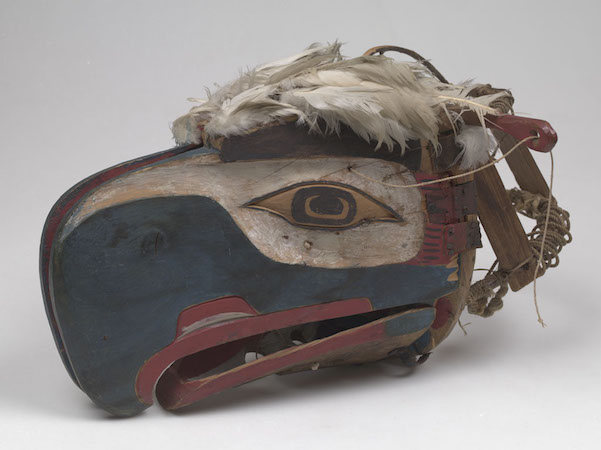Transformation mask
Kwakwaka'wakw, Northwest coast of Canada. Late 19th century C.E. Wood, paint, and string
The masks, whether opened or closed, are bilaterally symmetrical. Typical of the formline style is the use of an undulating, calligraphic line. The ovoid shape, along with s- and u-forms, are common features of the formline style.
Complete Identification:
Transformation mask
no known artist
Late 19th century
Red cedar wood, paint, and string
Kwakwaka’wakw
Northwest coast of Canada
Form:
Large, exaggerated bird head
Large beak
Opens to show a human face
Multiple bright colors
Hair made of string
Function:
Creates a powerful effect during ceremonies
Worn during potlatch where the host displays his status
Conveyed a high social status
Portrayed family genealogy–– could contain family crests
Passed between family members of a clan
Content:
In the shape of an eagle
Pull chords and the mask opens
The open form seems like a bird spreading its wings
The human face is of an ancestor
Uses elements of formline style
Bilaterally symmetrical when opened
Uses wavy, calligraphic lines
The eyes and other forms are ovoid (oval) shaped
S and U shapes are frequent
Context:
Mask worn during dance ceremonies
Dancers open the mask while dancing
Masks takes months to years to make
Carving techniques changed after tools introduced by Europeans etc. and brighter synthetic colors were also introduced
Transformation masks were an integral part of the culture and existed in multiple forms
Masks were worn with a cloak made of red cedar bark
Kwakiutl
Native name: Kwakwaka’wakw → group of people who speak the Kwakwaka’wakw language
They do not identify as a single nation
Pacific Northwest Coast indigenous people
Community is based on fishing
Men hunt and women gather fruits and berries
Weaving and woodwork
Wealth is defined by slaves and material goods
Potlatch → ceremony in which wealth is displayed
Wealth is seen as how much you can give away → wealth is given away during Potlatch
Potlatch was eventually banned by the United States government
Society is organized into communities, which are then organized into family units (loosely patriarchal ancestry) called na’mima (“of one kind”)
But are bilineal → ancestry could also be traced through mother’s side
Primogeniture political structure
Four classes: nobility, aristocracy, commoners, and slaves
Largely barter and trade economy → later became loosely currency based with wool blankets as the currency
Masks are very important in Kwakiutl culture → used in ceremonies and rituals
Religious beliefs have commonalities across Kwakwaka’wakw society
Thunderbird (important deity/creature/spirit across many indigenous peoples)
Polytheistic with several deities/spirits
Believe deceased ancestors are present around them
Themes:
Colonialism
Relationship with nature and natural world
Symbolic materials (cedar wood)
Animals and humans
Ceremonial dancing
Transformation and abstraction of human form
Ancestors, relationship with the past
Cross-Cultural Connections:
Masks are used across indigenous American cultures but exist in Africa and Asia as well
Masks that combine human and animal features are especially prominent in African art
The opened transformation mask reveals a face whose exaggerated features and bold colors are reminiscent of Japanese Noh and Kabuki theater masks and paint
Sources:
https://www.khanacademy.org/humanities/ap-art-history/indigenous-americas/a/transformation-masks
https://en.wikipedia.org/wiki/Kwakwaka%27wakw
https://en.wikipedia.org/wiki/Kwakwaka%27wakw_mythology

